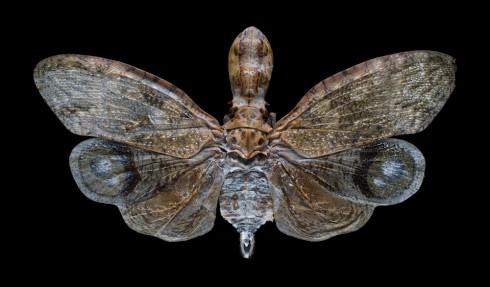A new study pieces together the puzzle of insect evolution
Insects — like this Fulgora laternaria planthopper — are the largest, most diverse group of animals on the planet. In this week’s issue of Science, researchers answer longstanding mysteries about their evolution. Study results suggest insects first developed wings before any other animal, over 400 million years ago.
A new study of insect evolution — the largest of its kind ever undertaken — has uncovered some surprising new information, confirmed some long-held hypotheses and may lead researchers toward a more comprehensive understanding of evolution.
One hundred scientists from 10 countries worked together to examine 144 insect species. Their goal was to create an insect “family tree” and establish a timeline of insect evolution. Their results were published recently in the journal Science.
“The scale of the project is amazing, not only in terms of the number of collaborators and the kind of scientists that were brought together, but also the data. It was just enormous,” says Michelle Trautwein, assistant curator and Schlinger Chair of Dipterology at the California Academy of Sciences in San Francisco.
The team of insect scientists was led by Bernard Misof at the University of Bonn. Misof brought together scientists who focus on DNA, scientists who study insect bodies and shapes, insect paleontologists and, finally, a team of computational scientists who developed new software and algorithms that could analyze the enormous amount of data.
“When I think about all the different types of entomologists that Bernie Misof had to wrangle, each with our own kind of pet hypotheses about how insects evolved and where species showed up — it was like herding cats,” Trautwein says. “It’s just a huge accomplishment.”
Scientists have been working to uncover the insect tree of life for a century, Trautwein says. The new study didn’t so much “provide shockingly new results — although that certainly is the case in some parts of the tree — but it did provide a huge, comprehensive amount of data to confirm the story that until now we’ve been able to tell only in bits and pieces,” she explains. “It’s really confirmation of the big, ancient and ongoing story of insect evolution.”
Insects appeared on Earth about 500 million years ago. They were some of the first animals on land and they started evolving around the same time as land plants. The two of them together helped form Earth’s early environments, Trautwein says. The earliest insect lineages were closely related to things like silverfish — flat, wingless, ground-dwelling insects. Then, about 400 million years ago, some insects evolved wings.
“The importance of this huge evolutionary transition just can’t be overstated,” Trautwein says. “It completely changed the trajectory of insect evolution.”
At that time, Trautwein explains, there was nothing else in the air — no birds or bats or flying reptiles. “The insects had this whole space all to themselves, which was incredible. It allowed them to disperse and distribute themselves in different ways [and] to escape predators — it was a big game changer in evolution.”
The study also revealed a correlation between insect wing development and changes in plant life. Insects gained wings when plants were gaining height and forests were starting to develop, so some connection exists between these milestones in evolution of life on Earth, Trautwein says. “That’s happened throughout the history of the evolution of life — different organisms evolve in synthesis with each other,” she explains.
The shared ancestry between lice and insects that have the genetic propensity for metamorphosis is going be “really controversial” to entomologists, Trautwein believes. Insects that undergo complete metamorphosis account for most of insect diversity. “They have this incredible ability to start as caterpillars or grubs or maggots and completely transform their body types, so that the larvae are totally different from the adults. That was also a huge milestone in insect evolution.”
In terms of sheer scale, the study’s examination of the insect genome also set a new standard. Over the past couple of decades, Trautwein says, researchers have looked at genes, but only at one or two at a time across insect populations. This project looked at 1,500 genes — a very big portion of all the expressed genes in the insect genome.
“That amount of data was so enormous that once we got it, it was too big to analyze: we didn’t have the computational power to deal with it,” Trautwein says. Even after new software and algorithms were put in place, the study ran on supercomputers for many months.
The new study also confirmed that insects are crustaceans — beetles are related to shrimp, in other words. From an evolutionary perspective this is significant, Trautwein says.
“Crustaceans are this big lineage of segmented creatures that have taken over the oceans. Insects, on the other hand, are a lineage that come out of crustaceans, but have instead taken over terrestrial environments,” she points out. “Both dominate the globe in different ways.”
But the study’s biggest contribution is the “framework of insect evolution” it built, Trautwein says. “This huge data set is going to give us the ability to ask a lot of specific questions about the genetic mechanisms behind some of the really big changes that happened in life on earth.”
This story is based on an interview that aired on PRI's Science Friday with Ira Flatow
Our coverage reaches millions each week, but only a small fraction of listeners contribute to sustain our program. We still need 224 more people to donate $100 or $10/monthly to unlock our $67,000 match. Will you help us get there today?
